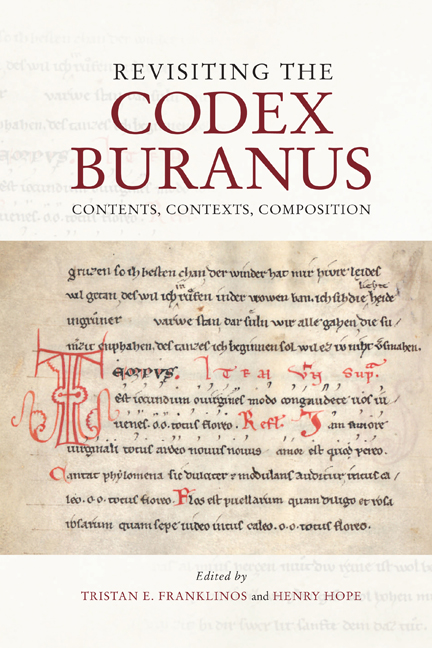Book contents
- Frontmatter
- Contents
- List of Illustrations
- Acknowledgements
- Abbreviations
- Dedication
- Introduction: The Codex Buranus – A Unique Challenge
- Chapter 1 A Modern Reception History of the Codex Buranus in Image and Sound
- Chapter 2 Parody in the Codex Buranus
- Chapter 3 Satire in the Codex Buranus
- Chapter 4 ‘Artes Amatorie Iam Non Instruuntur’: Learned and Erotic Discourse in the Carmina Burana
- Chapter 5 Classical Learning and Audience in the Carmina Amatoria: A Case-Study on CB 92
- Chapter 6 Rape, the Pastourelle, and the Female Voice in CB 185
- Chapter 7 Rethinking the Carmina Burana III: The Poetry of Peasants
- Chapter 8 Predestination and God’s Grace: The Salvific Architecture of the Religious Songs in the Codex Buranus
- Chapter 9 Revisiting the Plays of the Codex Buranus
- Chapter 10 Revisiting the Music of the Codex Buranus
- Chapter 11 Locating the Codex Buranus: Notational Contexts
- Chapter 12 Plurilingualism in the Codex Buranus: An Intercultural Reconsideration
- Chapter 13 Compilation, Contrafacture, Composition: Revisiting the German Texts of the Codex Buranus
- Afterword: multiformis armonia, scolaris symphonia
- List of Manuscripts
- Bibliography
- Index
- General Index
- Studies in Medieval and Renaissance Music
Introduction: The Codex Buranus – A Unique Challenge
Published online by Cambridge University Press: 16 September 2020
- Frontmatter
- Contents
- List of Illustrations
- Acknowledgements
- Abbreviations
- Dedication
- Introduction: The Codex Buranus – A Unique Challenge
- Chapter 1 A Modern Reception History of the Codex Buranus in Image and Sound
- Chapter 2 Parody in the Codex Buranus
- Chapter 3 Satire in the Codex Buranus
- Chapter 4 ‘Artes Amatorie Iam Non Instruuntur’: Learned and Erotic Discourse in the Carmina Burana
- Chapter 5 Classical Learning and Audience in the Carmina Amatoria: A Case-Study on CB 92
- Chapter 6 Rape, the Pastourelle, and the Female Voice in CB 185
- Chapter 7 Rethinking the Carmina Burana III: The Poetry of Peasants
- Chapter 8 Predestination and God’s Grace: The Salvific Architecture of the Religious Songs in the Codex Buranus
- Chapter 9 Revisiting the Plays of the Codex Buranus
- Chapter 10 Revisiting the Music of the Codex Buranus
- Chapter 11 Locating the Codex Buranus: Notational Contexts
- Chapter 12 Plurilingualism in the Codex Buranus: An Intercultural Reconsideration
- Chapter 13 Compilation, Contrafacture, Composition: Revisiting the German Texts of the Codex Buranus
- Afterword: multiformis armonia, scolaris symphonia
- List of Manuscripts
- Bibliography
- Index
- General Index
- Studies in Medieval and Renaissance Music
Summary
The manuscript known today as Munich, Bayerische Staatsbibliothek, Codex Latinus Monacensis (clm) 4660 was transferred from the Benedictine abbey of Benediktbeuern to its present home in 1803. It is unknown in which circumstances and at which juncture the manuscript came to Benediktbeuern. The codex nevertheless takes its name from the abbey in which it was rediscovered and is referred to as the Codex Buranus (‘the manuscript from Benediktbeuern’). The manuscript is frequently and erroneously called the Carmina Burana (‘songs from Benediktbeuern’), a term which properly denotes the lyric contents, not the codex itself. The present volume considers the manuscript as a whole, and thus uses the less common, but apposite term Codex Buranus throughout. The manuscript dates from around 1230 and is, in all likelihood, of South Tyrolian origin. The codex contains more than two hundred Latin texts, of which a handful contain parts in Romance languages and more than fifty have sections in Middle High German; it includes lyric songs, sententious uersus, and religious plays, the majority of which are preserved uniquely in the Codex Buranus. Fifty-one items feature notation (including the material in the Fragmenta Burana manuscript), and there are eight figural images in the codex as it survives. This volume contains a tabulation of the manuscript's textual contents, giving an immediate sense of the codex's breadth and its engagement with several contemporary cultural milieux, as well as its striking independence (see Illustrations 0.1 and 0.2). All manuscripts are, by their very nature, unique, but some, like the Codex Buranus, are much more unique than others.
Whilst a handful of medieval manuscripts have achieved a fleeting impact on the public imagination, the Codex Buranus has attained an extraordinary presence in the cultural imagination of many in the Western world through Carl Orff 's setting of parts of more than twenty of its songs. His Carmina Burana, first performed in 1937, conjured a colourful and daring portrayal of the lives of clerics in the High Middle Ages, and brought this monumental manuscript, its songs, and its images to a much wider audience than even the extensive scholarship on the codex might suggest it had reached.
- Type
- Chapter
- Information
- Revisiting the Codex BuranusContents, Contexts, Compositions, pp. 1 - 12Publisher: Boydell & BrewerPrint publication year: 2020



